Business Statistics Assignment: Exports, Sales, and Regression
VerifiedAdded on 2023/03/17
|10
|733
|61
Homework Assignment
AI Summary
This statistics assignment analyzes Australian export data, sales figures, and regression models. It includes bar charts, pie charts, frequency distributions, histograms, ogives, time series graphs, and scatter plots. The assignment explores the relationship between retail turnover per capita and final c...

STATISTICS FOR BUSINESS
STUDENT ID:
[Pick the date]
STUDENT ID:
[Pick the date]
Paraphrase This Document
Need a fresh take? Get an instant paraphrase of this document with our AI Paraphraser
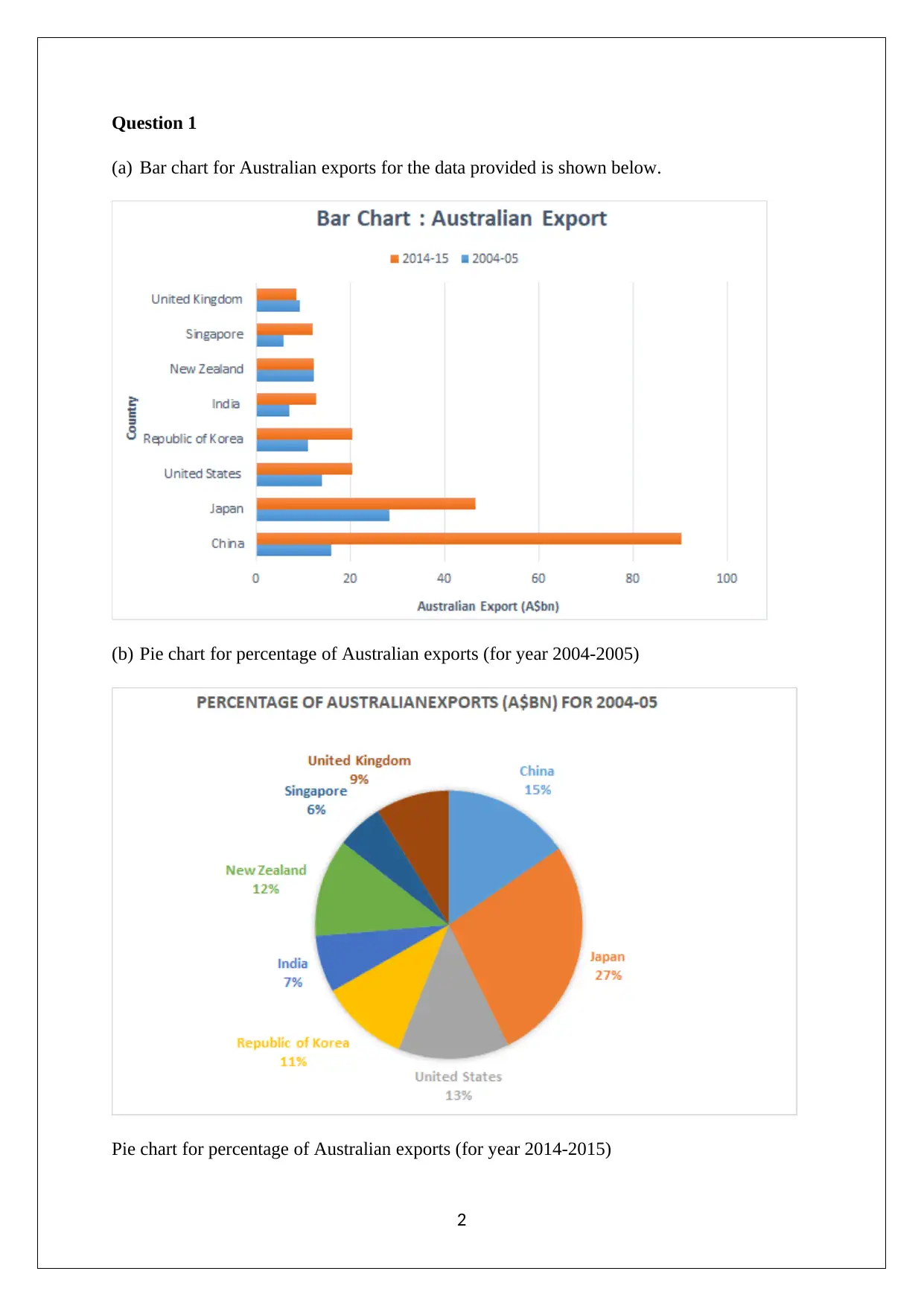
Question 1
(a) Bar chart for Australian exports for the data provided is shown below.
(b) Pie chart for percentage of Australian exports (for year 2004-2005)
Pie chart for percentage of Australian exports (for year 2014-2015)
2
(a) Bar chart for Australian exports for the data provided is shown below.
(b) Pie chart for percentage of Australian exports (for year 2004-2005)
Pie chart for percentage of Australian exports (for year 2014-2015)
2
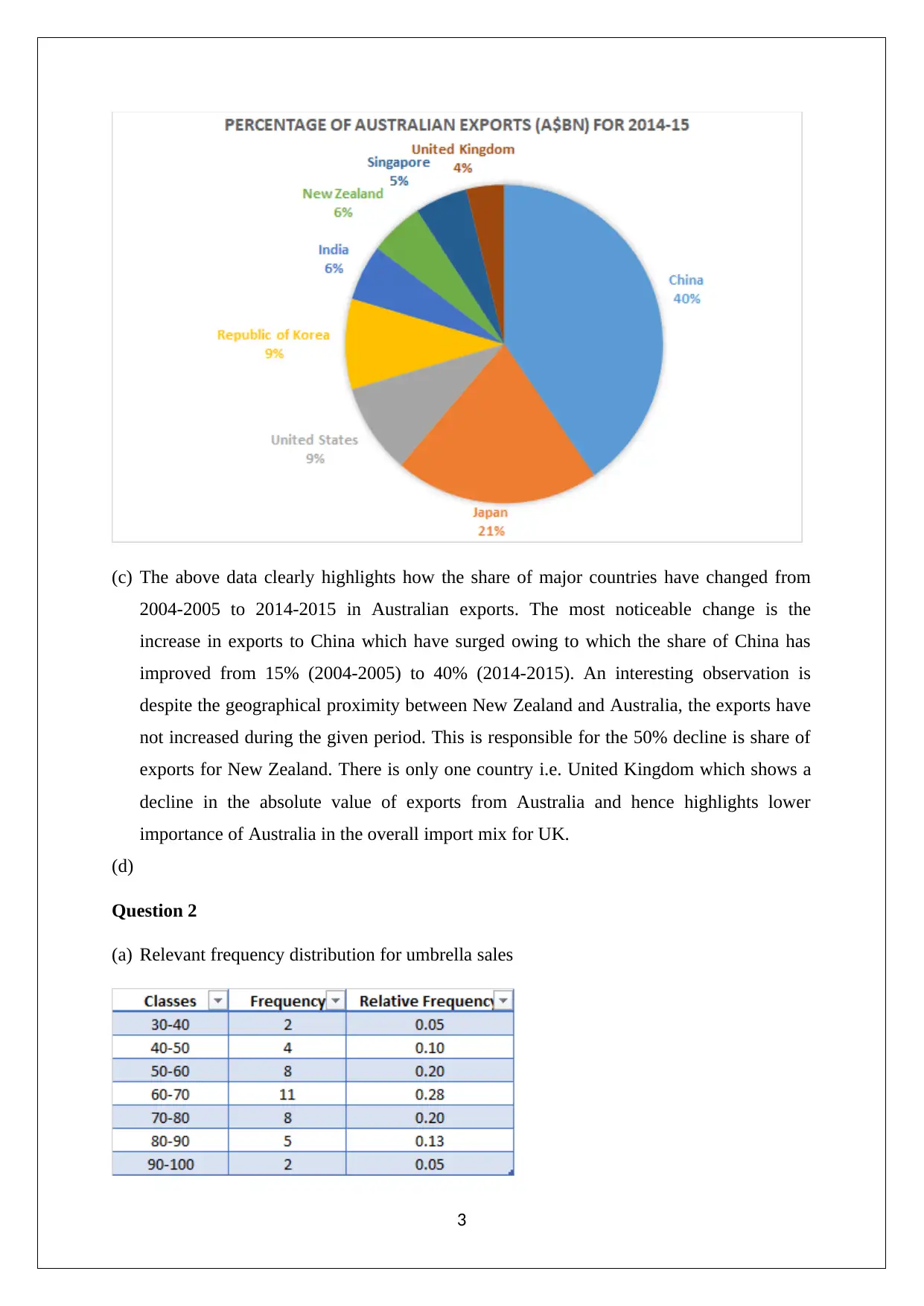
(c) The above data clearly highlights how the share of major countries have changed from
2004-2005 to 2014-2015 in Australian exports. The most noticeable change is the
increase in exports to China which have surged owing to which the share of China has
improved from 15% (2004-2005) to 40% (2014-2015). An interesting observation is
despite the geographical proximity between New Zealand and Australia, the exports have
not increased during the given period. This is responsible for the 50% decline is share of
exports for New Zealand. There is only one country i.e. United Kingdom which shows a
decline in the absolute value of exports from Australia and hence highlights lower
importance of Australia in the overall import mix for UK.
(d)
Question 2
(a) Relevant frequency distribution for umbrella sales
3
2004-2005 to 2014-2015 in Australian exports. The most noticeable change is the
increase in exports to China which have surged owing to which the share of China has
improved from 15% (2004-2005) to 40% (2014-2015). An interesting observation is
despite the geographical proximity between New Zealand and Australia, the exports have
not increased during the given period. This is responsible for the 50% decline is share of
exports for New Zealand. There is only one country i.e. United Kingdom which shows a
decline in the absolute value of exports from Australia and hence highlights lower
importance of Australia in the overall import mix for UK.
(d)
Question 2
(a) Relevant frequency distribution for umbrella sales
3
⊘ This is a preview!⊘
Do you want full access?
Subscribe today to unlock all pages.

Trusted by 1+ million students worldwide
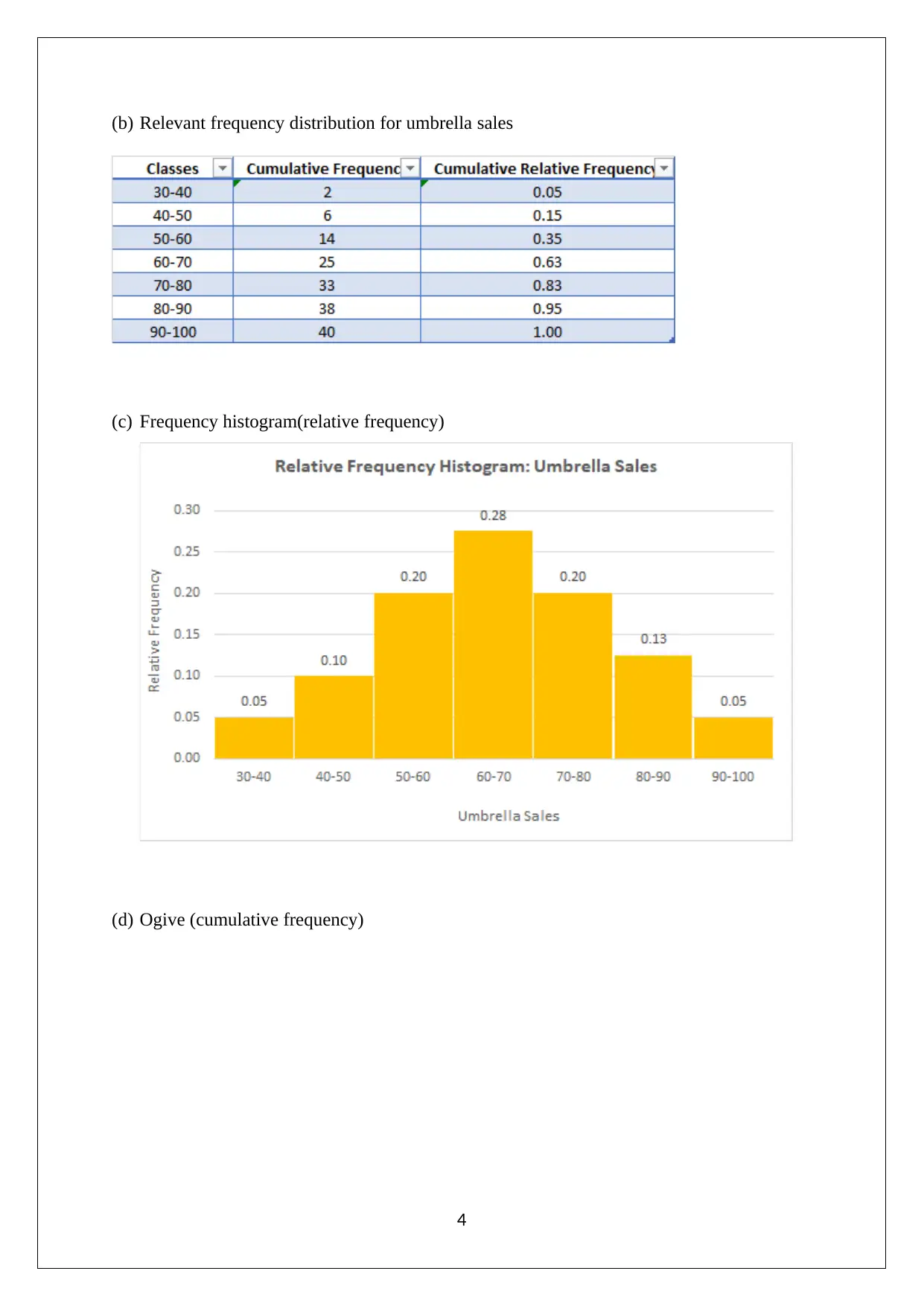
(b) Relevant frequency distribution for umbrella sales
(c) Frequency histogram(relative frequency)
(d) Ogive (cumulative frequency)
4
(c) Frequency histogram(relative frequency)
(d) Ogive (cumulative frequency)
4
Paraphrase This Document
Need a fresh take? Get an instant paraphrase of this document with our AI Paraphraser
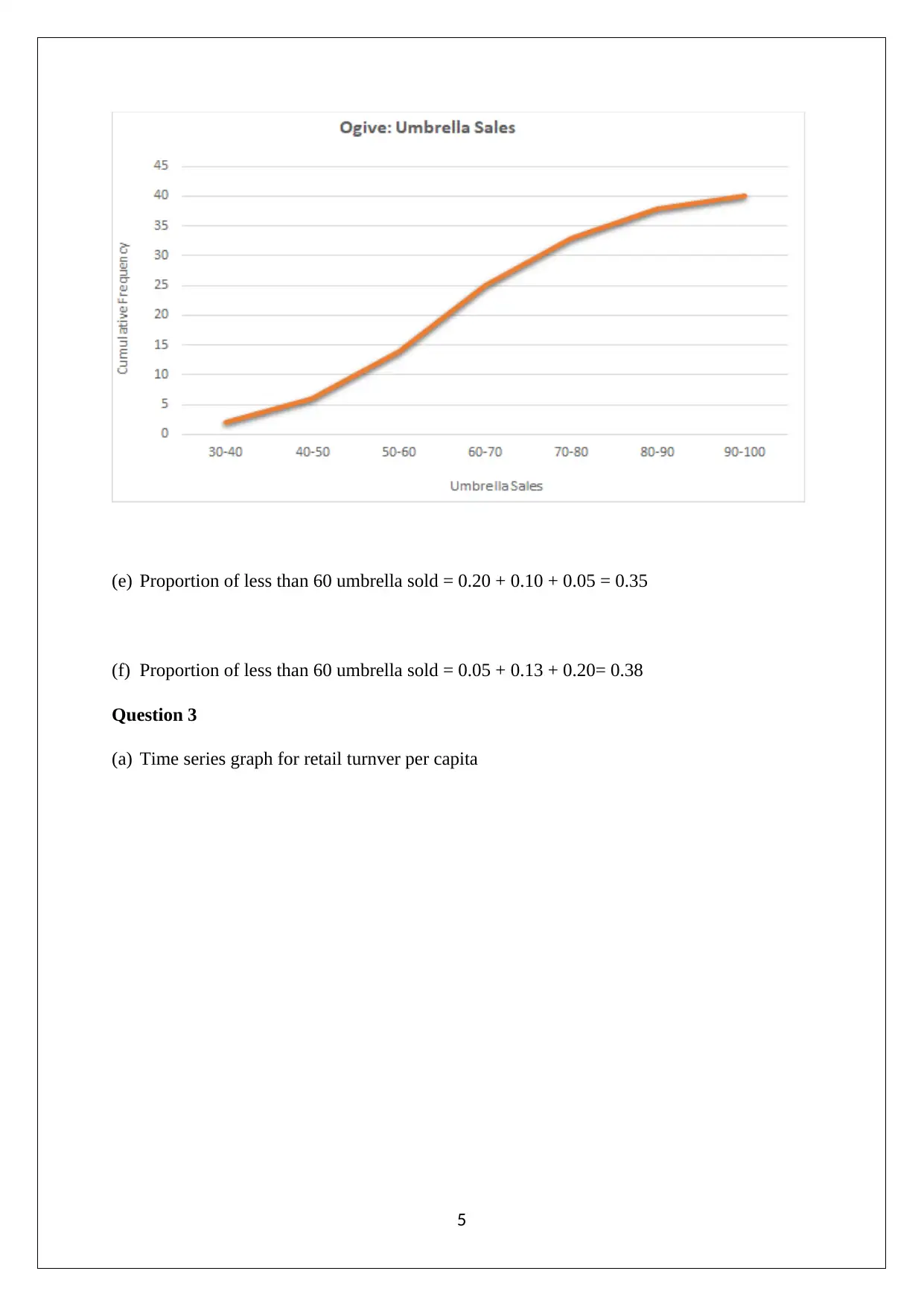
(e) Proportion of less than 60 umbrella sold = 0.20 + 0.10 + 0.05 = 0.35
(f) Proportion of less than 60 umbrella sold = 0.05 + 0.13 + 0.20= 0.38
Question 3
(a) Time series graph for retail turnver per capita
5
(f) Proportion of less than 60 umbrella sold = 0.05 + 0.13 + 0.20= 0.38
Question 3
(a) Time series graph for retail turnver per capita
5

Time series graph for final consumption expenditure
(b) Scatter plot
6
(b) Scatter plot
6
⊘ This is a preview!⊘
Do you want full access?
Subscribe today to unlock all pages.

Trusted by 1+ million students worldwide
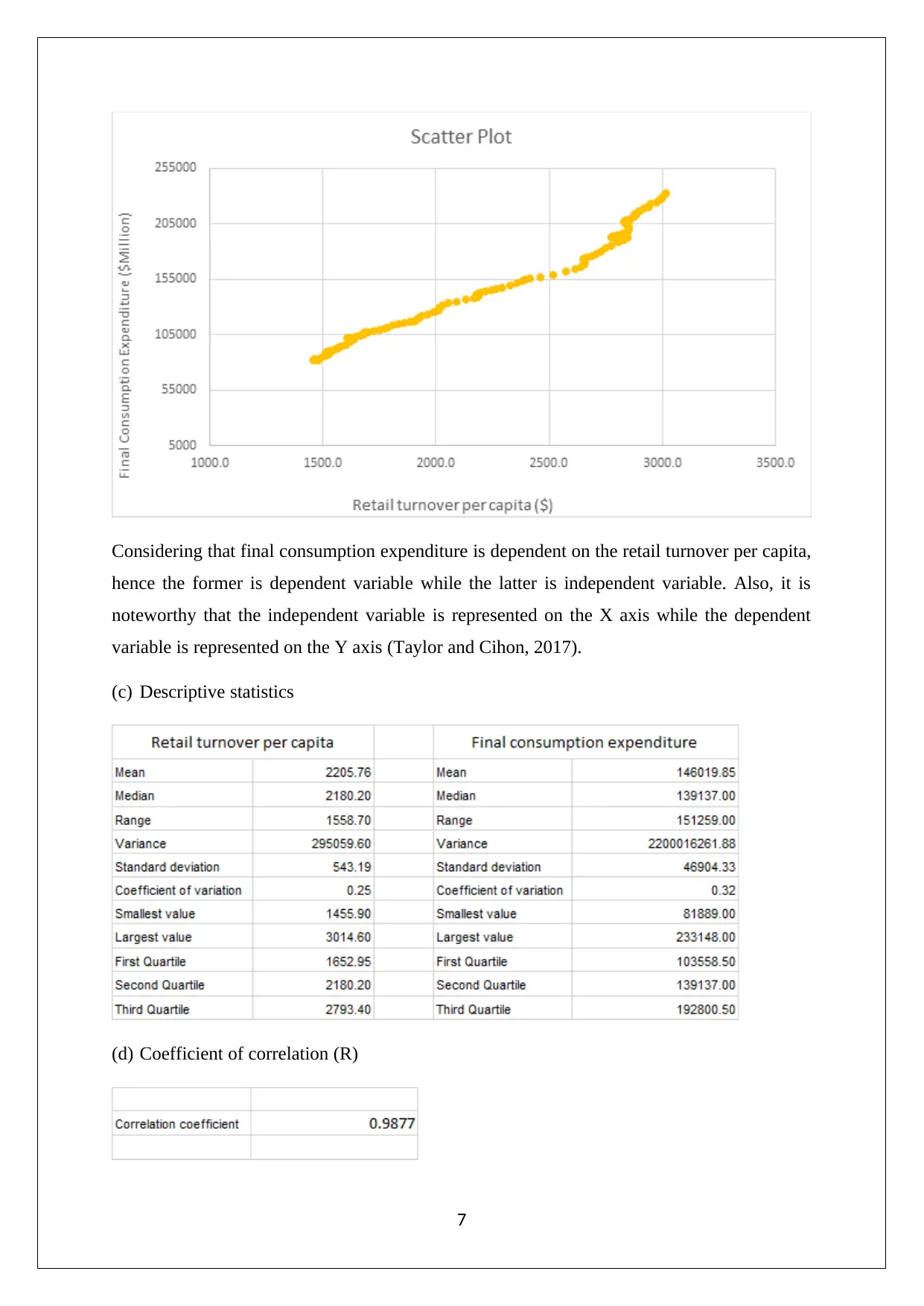
Considering that final consumption expenditure is dependent on the retail turnover per capita,
hence the former is dependent variable while the latter is independent variable. Also, it is
noteworthy that the independent variable is represented on the X axis while the dependent
variable is represented on the Y axis (Taylor and Cihon, 2017).
(c) Descriptive statistics
(d) Coefficient of correlation (R)
7
hence the former is dependent variable while the latter is independent variable. Also, it is
noteworthy that the independent variable is represented on the X axis while the dependent
variable is represented on the Y axis (Taylor and Cihon, 2017).
(c) Descriptive statistics
(d) Coefficient of correlation (R)
7
Paraphrase This Document
Need a fresh take? Get an instant paraphrase of this document with our AI Paraphraser
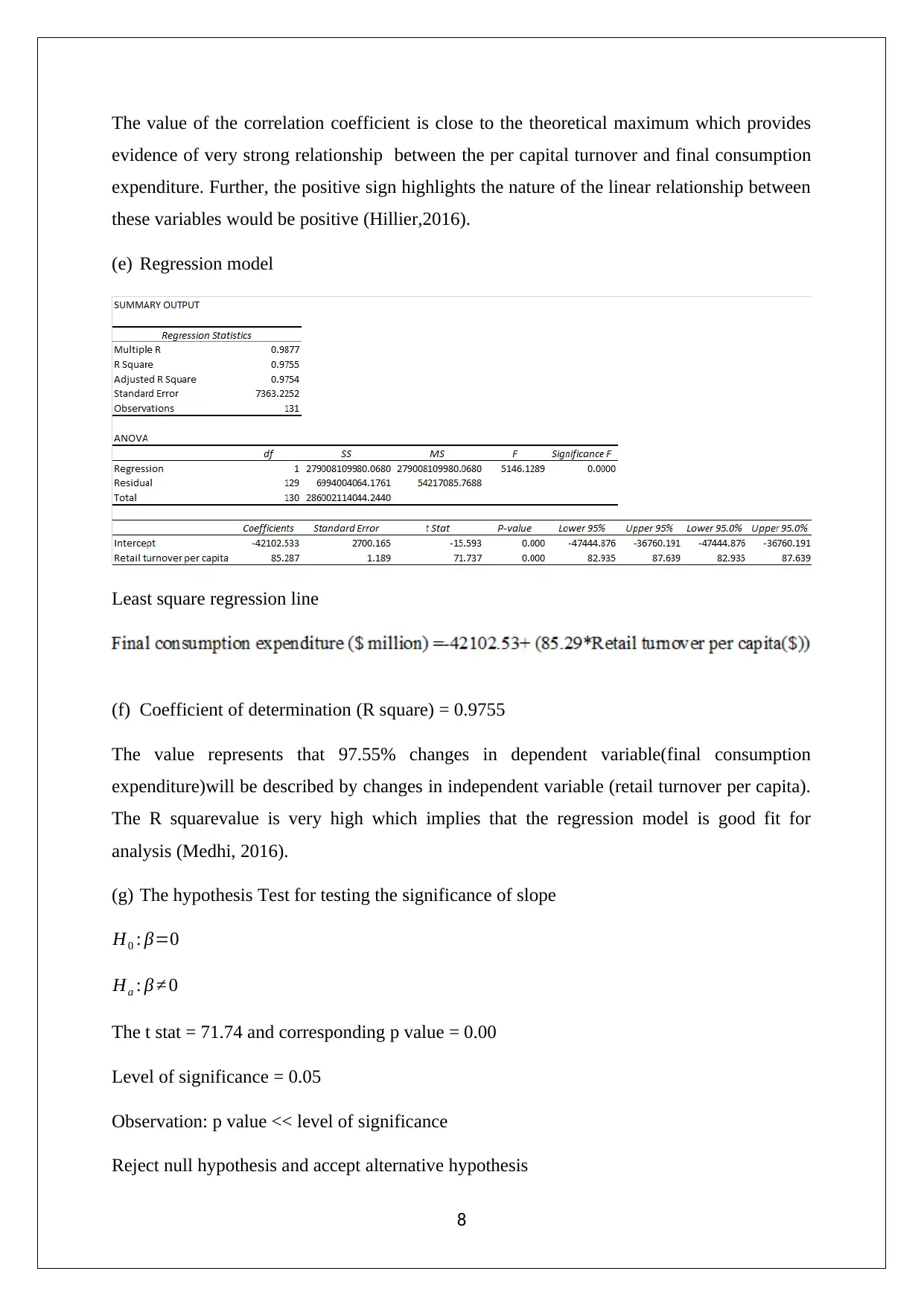
The value of the correlation coefficient is close to the theoretical maximum which provides
evidence of very strong relationship between the per capital turnover and final consumption
expenditure. Further, the positive sign highlights the nature of the linear relationship between
these variables would be positive (Hillier,2016).
(e) Regression model
Least square regression line
(f) Coefficient of determination (R square) = 0.9755
The value represents that 97.55% changes in dependent variable(final consumption
expenditure)will be described by changes in independent variable (retail turnover per capita).
The R squarevalue is very high which implies that the regression model is good fit for
analysis (Medhi, 2016).
(g) The hypothesis Test for testing the significance of slope
H0 : β=0
Ha : β ≠ 0
The t stat = 71.74 and corresponding p value = 0.00
Level of significance = 0.05
Observation: p value << level of significance
Reject null hypothesis and accept alternative hypothesis
8
evidence of very strong relationship between the per capital turnover and final consumption
expenditure. Further, the positive sign highlights the nature of the linear relationship between
these variables would be positive (Hillier,2016).
(e) Regression model
Least square regression line
(f) Coefficient of determination (R square) = 0.9755
The value represents that 97.55% changes in dependent variable(final consumption
expenditure)will be described by changes in independent variable (retail turnover per capita).
The R squarevalue is very high which implies that the regression model is good fit for
analysis (Medhi, 2016).
(g) The hypothesis Test for testing the significance of slope
H0 : β=0
Ha : β ≠ 0
The t stat = 71.74 and corresponding p value = 0.00
Level of significance = 0.05
Observation: p value << level of significance
Reject null hypothesis and accept alternative hypothesis
8
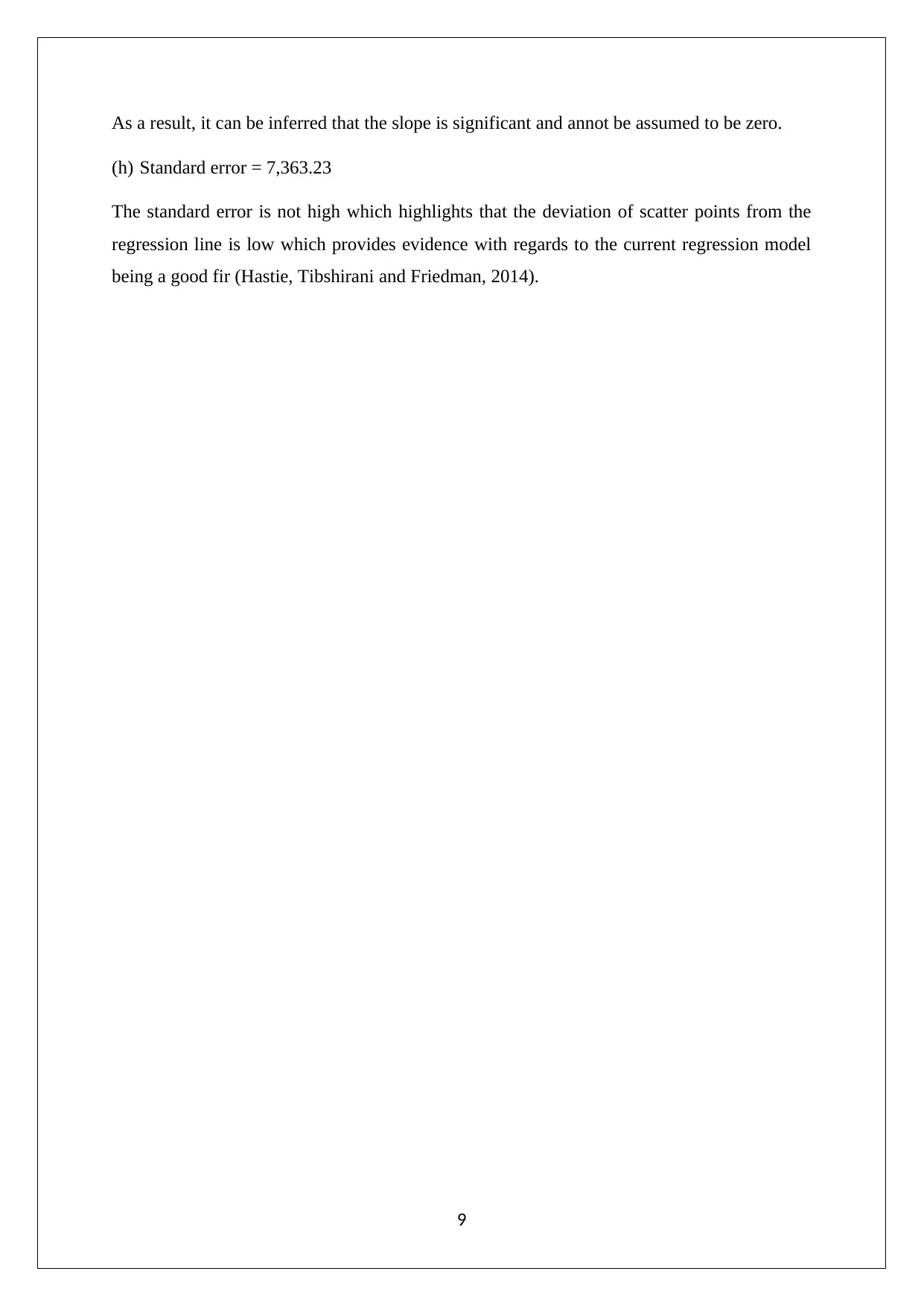
As a result, it can be inferred that the slope is significant and annot be assumed to be zero.
(h) Standard error = 7,363.23
The standard error is not high which highlights that the deviation of scatter points from the
regression line is low which provides evidence with regards to the current regression model
being a good fir (Hastie, Tibshirani and Friedman, 2014).
9
(h) Standard error = 7,363.23
The standard error is not high which highlights that the deviation of scatter points from the
regression line is low which provides evidence with regards to the current regression model
being a good fir (Hastie, Tibshirani and Friedman, 2014).
9
⊘ This is a preview!⊘
Do you want full access?
Subscribe today to unlock all pages.

Trusted by 1+ million students worldwide

References
Hastie, T., Tibshirani, R. and Friedman, J. (2014) The Elements of Statistical Learning. 4th
ed. New York: Springer Publications, pp. 156
Hillier, F. (2016) Introduction to Operations Research.6th ed.New York: McGraw Hill
Publications, pp. 178
Medhi, J. (2016) Statistical Methods: An Introductory Text. 4th ed. Sydney: New Age
International, pp. 123
Taylor, K. J. and Cihon, C. (2017) Statistical Techniques for Data Analysis. 2nd ed.
Melbourne: CRC Press, pp. 198
10
Hastie, T., Tibshirani, R. and Friedman, J. (2014) The Elements of Statistical Learning. 4th
ed. New York: Springer Publications, pp. 156
Hillier, F. (2016) Introduction to Operations Research.6th ed.New York: McGraw Hill
Publications, pp. 178
Medhi, J. (2016) Statistical Methods: An Introductory Text. 4th ed. Sydney: New Age
International, pp. 123
Taylor, K. J. and Cihon, C. (2017) Statistical Techniques for Data Analysis. 2nd ed.
Melbourne: CRC Press, pp. 198
10
1 out of 10
Related Documents
Your All-in-One AI-Powered Toolkit for Academic Success.
+13062052269
info@desklib.com
Available 24*7 on WhatsApp / Email
![[object Object]](/_next/static/media/star-bottom.7253800d.svg)
Unlock your academic potential
© 2024 | Zucol Services PVT LTD | All rights reserved.





